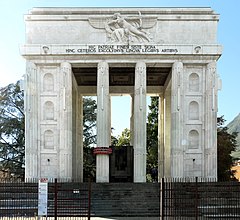Bolzano Victory Monument




The Victory Monument (Italian: Monumento alla Vittoria; German: Siegesdenkmal) is a monument in Bolzano, northernmost Italy, erected on the personal orders of Benito Mussolini in South Tyrol, which had been annexed from Austria after World War I. The 19 metre wide Victory Gate was designed by architect Marcello Piacentini and substituted the former Austrian Kaiserjäger monument, torn down in 1926–27. Its construction in Fascist style, displaying lictorial pillars, was dedicated to the "Martyrs of World War I".
The following Latin script can be seen on the main façade:
- HIC PATRIAE FINES SISTE SIGNA / HINC CETEROS EXCOLVIMVS LINGVA LEGIBVS ARTIBVS
- Here at the border of the fatherland set down the banner. From this point on we educated the others with language, law and culture.
The monument was inaugurated on 12 July 1928 by King Victor Emmanuel III and major representatives of the fascist government.
The inscription, referring to Roman imperial history, was seen as provocative by many within the German-speaking majority in the province of South Tyrol. On the day of the inauguration there was a counter-demonstration with 10,000 people in Innsbruck.[1]
Since its construction, the monument has been a focal point of the tensions between the
Only in 2014, by a joint decision taken by the Italian Ministry of Culture, the South Tyrolean Provincial Government and the Municipality of Bolzano, the Monument has been reopened to the public along with a permanent exhibition (under the title "BZ '18–'45: one monument, one city, two dictatorships") focussing on the history of the monument, within the context of Fascism and the Nazi occupation.[3]
In 2016, the exhibition was granted a special commendation by the Judging Panel of the European Museum of the Year Award which pointed out that "the exhibition reintegrates a controversial monument, which has long served as the focal point of battles over politics, culture, and regional identity. The project is a highly courageous and professional initiative to promote humanism, tolerance and democracy."[4]
Similarly to the Victory Monument, in 2017 also the former
Further reading
- Hökerberg, Håkan (2017), "The Monument to Victory in Bolzano: desacralisation of a fascist relic", in International Journal of Heritage Studies, vol. 24, pp. 1–16.
- Obermair, Hannes (2017), "Monuments and the City—an almost inextricable entanglement", in Matthias Fink; et al. (eds.), Multiple Identitäten in einer "glokalen Welt"—Identità multiple in un "mondo glocale"—Multiple identities in a "glocal world", Bozen-Bolzano: ISBN 978-88-98857-35-7
- Kraus, Carl; Obermair, Hannes (2019). Mythen der Diktaturen. Kunst in Faschismus und Nationalsozialismus – Miti delle dittature. Arte nel fascismo e nazionalsocialismo. Südtiroler Landesmuseum für Kultur- und Landesgeschichte Schloss Tirol. pp. 116–17. ISBN 978-88-95523-16-3.
- di Michele, Andrea (2020), "Storicizzare i monumenti fascisti. Il caso di Bolzano", in Geschichte und Region/Storia e regione, vol. XXIX, 2, pp. 149–67; also in English transl. (2022), "Fascist Monuments on the Border. The Case of Bolzano/Bozen, South Tyrol", in Id., Filippo Focardi (eds.), Rethinking Fascism. The Italian and German Dictatorships, Berlin/Boston, de Gruyter, pp. 247–74. https://doi.org/10.1515/9783110768619-013
- ISBN 978-0-367-34851-9, pp. 533–45.
- Bevan, Robert (2022). Monumental Lies. Culture Wars and the Truth about the Past. London-New York: Verso. pp. 22–27, 283–84. ISBN 978-1-83976-187-4.
References
- ^ Marilena Pinzger: Steinernes Zeichen des Imperiums. University of Vienna, 2011, p. 92
- ISBN 978-3-85256-713-6, p. 134.
- ^ "Faschistisches Siegesdenkmal entpolitisiert". Der Standard. Vienna. 25 July 2014. Retrieved 30 November 2015.
- ^ European Museum of the Year Award 2016. Retrieved 1 May 2016.
- ISBN 978-88-98857-35-7
External links
- Official Website
- Sakalis, Alex (January 18, 2022). "What happens to fascist architecture after fascism?". bbc.com.
- Niland, Josh (January 20, 2022). "This small Italian town could be the answer to debate surrounding monuments removal". archinect.com.
- Wann, Ann (August 25, 2022). "Italy's decision not to tear down statues, with Dr Hannes Obermair". Coffee & Cocktails Podcast. Retrieved July 11, 2023.
- Obermair, Hannes (January 26, 2022). "The Bas-Relief in Bolzano-Bozen". Contested Histories Onsite. Retrieved July 3, 2022.
See also
46°30′02″N 11°20′42″E / 46.50056°N 11.34500°E
